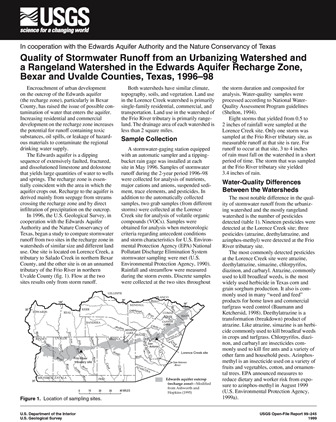Quality of Stormwater Runoff from an Urbanizing Watershed and a Rangeland Watershed in the Edwards Aquifer Recharge Zone, Bexar and Uvalde Counties, Texas, 1996-98

| Author | Ging PB |
| Year | 1999 |
| Description | Water quality study on stormwater runoff in an urbanizing vs rural area of the Edwards Aquifer Recharge Zone |
| Report Number | USGS O-FR 99-245 |
| Publisher | US Geological Survey |
| Location | Edwards Aquifer Recharge Zone, Bexar County, Uvalde County |
| Cover | View Download |
| File | View Download |
| Summary |
|
…In 1996, the U.S. Geological Survey, in cooperation with the Edwards Aquifer Authority and the Nature Conservancy of Texas, began a study to compare stormwater runoff from two sites in the recharge zone in watersheds of similar size and different land use. One site is located on Lorence Creek, a tributary to Salado Creek in northern Bexar County, and the other site is on an unnamed tributary of the Frio River in northern Uvalde County (fig. 1). Flow at the two sites results only from storm runoff. Both watersheds have similar climate, topography, soils, and vegetation. Land use in the Lorence Creek watershed is primarily single-family residential, commercial, and transportation. Land use in the watershed of the Frio River tributary is primarily rangeland. The drainage area of each watershed is less than 2 square miles…. The most notable difference in the quality of stormwater runoff from the urbanizing watershed and the mostly rangeland watershed is the number of pesticides detected (table 1). Nineteen pesticides were detected at the Lorence Creek site; three pesticides (atrazine, deethylatrazine, and azinphos-methyl) were detected at the Frio River tributary site….Six VOCs were detected in the two grab samples collected at the Lorence Creek site. Four of the six VOCs detected (1,2,4-trimethylbenzene, benzene, ethylbenzene, and xylenes) are used as gasoline additives (Lucius and others, 1992). Concentrations of all pesticides and VOCs detected for which EPA has established maximum allowable or recommended concentrations for drinking water were less than those maximums (U.S. Environmental Protection Agency, 1999b). |
Search for Documents
Advance Search
Explore EAA's Scientific Reports
- All Reports
- Groundwater Movement
- Geomorphology and Caves
- Weather Modification
- Geology
- Water Use and Conservation
- Geochemistry
- Water Resources Planning and Management
- Floods and Drought
- Water Quality
- Climatology
- Surface Water / Groundwater Relationship
- Biology
- Springs, Groundwater Discharge
- Archaeology
- RZ Protection
- Aquifer Levels
- Remote Sensing
- Precipitation
- Overview Studies
- Modeling
- Hydrology and Hydrogeology
- History
- Groundwater Recharge, Recharge Zone
